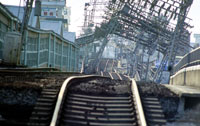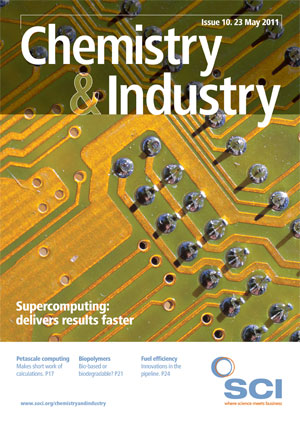If Henry Ford was alive today he would be forced to update his famous description of the company’s paint range with this advice to customers in America: ‘Any colour you like as long as it’s not black.’ Ford Motor Company’s recent refusal to accept orders in Tuxedo Black for many US built models is a direct consequence of the most powerful earthquake ever recorded in Japan. The temporary restriction on Ford’s range of bodywork finishes is perhaps an insignificant result of the earthquake and consequent tsunami that hit Honshu Island’s north-east coast near the city of Sendai on 11 March 2011. But it does illustrate just how far and how swiftly the ripples of this catastrophe have spread in the interconnected world of global chemicals and pharmaceuticals.
Vulnerable components
The impact of Japan’s worst natural disaster, which has killed an estimated 25,000 people, destroyed or badly damaged some 125,000 buildings and threatened millions with potentially harmful nuclear emissions, has been felt particularly badly in the car industry. The vulnerability of component makers to disruptions, which is due to deeply entrenched ‘just-in-time’ supply economics, has been exposed.
Honda, Nissan and Toyota have all been forced to suspend or reduce production, owing to shortages of key components. Toyota, the world’s biggest car manufacturer, has underlined the severity of the situation by admitting that its worldwide operations will probably not be back to normal before November or December 2011. Honda has also indicated that it is unlikely to achieve preearthquake output levels before Q3 2011.
The experience of German chemicals and pharmaceuticals group Merck has demonstrated how the loss of a single product can have ramifications way beyond the affected factory. Merck’s plant at Onahama, some 135 miles north-east of Tokyo and 35 miles south of Fukushima, is the only plant in Japan to make Xirallic, an enhanced aluminium oxide used in metallic paints to give a glistening or shimmering appearance. The plant sustained some damage during the earthquake but has been closed mainly because of the loss of electricity and other utilities and because of its proximity to the devastated Fukushima nuclear power complex where damaged reactors continue to pose a serious threat to the local population. Production finally resumed on 8 May.
Ford and other major car manufacturers, including Chrysler, Toyota and General Motors, use Xirallic paint and they have been forced to stop taking orders for cars with this finish. It has been estimated that US car manufacturers could lose up to about 450,000 sales between April and June 2011 because of the Japanese disaster. Although the inability to offer certain coatings is arguably a minor inconvenience, shortages of Japanese made electronics parts and automotive polymers, such as acrylonitrilebutadiene- styrene, are not. And they have had a disproportionate impact on car production, both in the US and elsewhere.
Chemical plants threatened
Indeed, damage and disruption to a wide range of chemicals and utilities plants in the most affected industrial cities of Chiba and Kashima have caused power supply problems, shortages in several critical petrochemical products and, initially at least, sent prices spiralling as just-in-time plant logistics policies exacerbate shortfalls. Almost all the major chemical producers in Japan have been affected, if not directly by plant damage then indirectly by subsequent cuts in supplies of electricity, industrial gases, water or key feedstocks. The disruption in power supplies has been the major reason why chemical plants as far away from Sendai as Kawasaki have been forced to close or reduce output.

Other Japanese chemical majors seriously affected include Maruzen, Mitsui, Sumitomo and Asahi Glass, while cracker and refinery outages at Nippon Oil & Energy have had a widespread effect on feedstock availability and power supplies.
Sumitomo’s caprolactam plant at Ehime in the Shikoku region was forced to close because of a shortage in hydrogen peroxide feedstock. The plant could, of course, resume output quite quickly if the feedstock situation improves. But Asahi Glass has said its plants at Kashima are likely to be out for several months.
Japanese companies were not alone, German chemicals giant BASF was among the non-Japanese majors to suffer from the earthquake and tsunami. The company says that several sites were still shut in late April, including the Isohara performance chemicals unit which suffered earthquake damage, and the Koriyama crop protection facility because of its proximity to Fukushima.
Pharmaceuticals unaffected
The impact on global pharmaceutical majors appears to be less serious. GlaxoSmithKline’s operations at its manufacturing site in Imaichi were temporarily suspended due to minor plant damage. Medicines manufactured at Imaichi include antidepressants, antivirals and dermatology products. The company reports: ‘Repairs have now been made and production and packaging capability have been restored. However, energy supply would continue to be challenging over the coming summer months.’
AstraZeneca says its major facilities, including Osaka headquarters and manufacturing and packaging site in Maihara, in Shiga prefecture, had been largely unaffected by the earthquake. Towards the end of April, the company was not experiencing, nor did it expect, any disruption to supply.
Long-term costs
Once reliable supplies of power and fuel can be resumed, and the situation at the Fukushima nuclear complex at least contained, Japanese chemicals producers should be able to overcome many of their current earthquake and tsunami related problems.
But the disaster’s impact on the global chemicals industry is unlikely to end when all affected plants and supply chains are back to normal. It has been estimated that the earthquake will cost the world’s insurance industry up to about $30bn, with the Lloyd’s of London market share put at up to around $800m.
Insurers will almost certainly seek to recoup at least some of these losses through substantially higher premiums. Operators of chemicals and pharmaceuticals plants in areas subject to earthquakes, especially those vulnerable to tsunamis, can expect to face the biggest premium hikes. But business interruption insurance, where obtainable, also seems certain to become significantly more costly in the light of widespread disruption in Japan from power outages.
One of the lessons already being taken from this disaster has been the speed with which such an interruption in production in a major industrial country like Japan can so quickly spread around the globe, especially when vital electronic components made by relatively few manufacturers are concerned.
It is probably too early and perhaps rather unrealistic to expect chemicals and automotive industries to diversify their sources of supply from hitherto highly competitive and reliable Asian manufacturers. But should a global major like Japan or China suffer a catastrophe of the scale and impact that occurred in March 2011, a more far-reaching and fundamental reassessment of ‘just-in-time’ supply and logistics policies may be needed.
Neil Sinclair is a freelance journalist based in London, UK.




